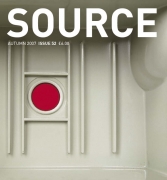Inhabiting an Inhuman Situation
Manuel Vason: Encounters Arnolfini, Bristol 9th June - 1st July 2007
Review by Nancy Roth
Issue 52 Autumn 2007
View Contents ▸
The exhibition space is dark except for overhead spotlights that illuminate a few of the large images for a while, and then switch off and are replaced by other. Visitors quickly learn that they themselves control the lighting by standing in front of a particular photograph. Most settle into a systematic journey around the room, the lighting system registering any given viewer's attention to each image in turn. Almost all the photographs depict single figures, usually scaled so that the figure appears at about life-size. The colour is sumptuous, the printing meticulous. It adds up to a sense of improbably intimate, serial encounters with bodies in extremis: many naked, some in pain, most in precarious circumstances - covered with rubbish, covered with ash, about to fall, left unconscious - grappling with a core of human experience.
Manuel Vason is a photographer who works with performance artists, including some of the most prominent working today: Ron Athey, Franko B, Stuart Brisley, Alastair MacLennan, Kira O'Reilly, and Guillermo Gomez-Pena. Each photograph in this exhibition was made during a performance staged specifically for the purpose (Vason was the sole spectator). That is, each was a separate project in which artist and photographer collaboratively constructed a photograph, ostensibly making the relationship between the two the open question, the field of Vason's photography. Ron Athey and Manuel Vason Collaboration #3, Glasgow 2006 - Courtesy Arnolfini Gallery
Ron Athey and Manuel Vason Collaboration #3, Glasgow 2006 - Courtesy Arnolfini Gallery
And in fact everything about this exhibition seems to guide us to regard these images in relation to specific performances, and to thinking about how photographs do, or do not, record, document or refer to such events. The two major texts in the very elegant and substantial catalogue, for example, both address this relationship. Rebecca Schneider's innovatively quarrels with photography's inevitable 'failure' to adequately document performance, to effectively hold, or reproduce the past event. She proposes instead a kind of circulation, in which photographs and performances creatively participate. The catalogue contains many additional texts by the performance artists who collaborated with Vason, and the Arnolfini presented a programme of performance events, as well a symposium focused on performance art and photography. Vason himself designed the lighting system, which reproduced some of the effects of an actual performance.
If this structure of meaning could be sketched, it might look like an asterisk with a viewer in the centre: behind each photograph is a unique, collaborative event in which the photograph was produced, and behind each of these, an actual performance. All lines converge on the viewer. But I was not the only visitor who had not seen the performances, and was therefore unable to judge the adequacy or accuracy of any photograph against the effect of the performance it recorded. Neither, I suspect, was I the only one to find herself losing awareness of the performances, yet without losing interest in the photographs at all. I began almost immediately to read meanings against the grain of the suggested model, that is, not in terms of the photographs' relationship to a past event, but in terms of their differences and similarities to one another and to other images I brought with me. Not exactly an asterisk, then, but something more like circle of windows or viewpoints, giving me various perspectives on an extremely complex, yet potentially coherent phenomenon.
Taken together, Vason's photographs attest to a central preoccupation with the beauty and potential, the vulnerability and limitation of human bodies. A man (Alastair MacLennan) sits quietly, alone, at a landfill site, rubbish stretching beyond the picture frame to infinity; a woman (Francesca Steele) lies naked on a surface covered with teacups and flowers; a man (Franko B) seems to dance beautifully, despite hanging suspended by four ropes attached to his wrists and ankles, his feet never touching the ground. In these photographs, bodies appear in impossible, absurd situations, pierced by needles or feathers, held by clamps, wrapped, costumed part male, part female, or part machine. There is a very consistent intensity about them, a sense that the transgressions against propriety and comfort, the sheer strangeness of many of them, is significant in a context we may not know in detail, but we do know is testing the edges of what is possible and bearable by human beings. For some viewers, perhaps not all, these images are surely statements about a shared human experience - of things extremely sad, silly, awkward, painful and confusing.
The 'framing' of this work is given not by performance art as a discipline, but by Vason himself, through his decisions to work with particular artists, his capacity to create an atmosphere of trust and respect with them, and his highly consistent aesthetic. An artist who constantly collaborates with others, who insists on having the performer sign each work along with him, he emerges in this exhibition with a very clear, articulate identity that shares much with the respective performers, but finally constitutes something that is less and more than any of them. A bit like a curator who might reveal or discover a new genre by assembling examples, Vason has constructed a field less concerned with questions of photographic representation or documentation than with human bodies inhabiting an inhuman situation. They - we - appear absurd, out of place, agonized or vulnerable, and still, sometimes, very strong and beautiful.
Other articles by Nancy Roth:
Other articles on photography from the 'Performance' category ▸






